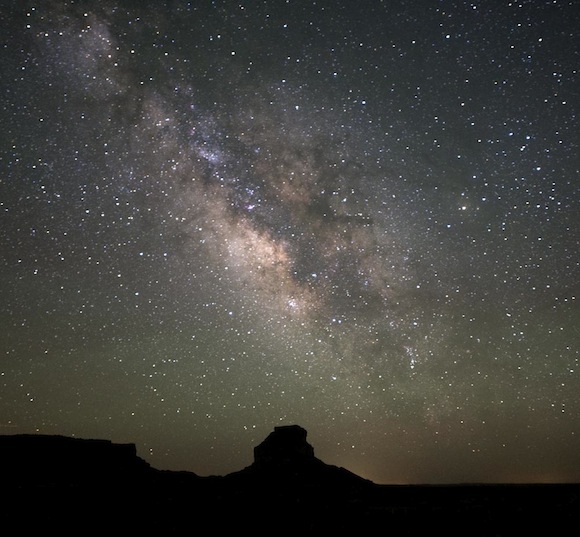 By Glenn A. Walsh
Reporting for SpaceWatchtower
By Glenn A. Walsh
Reporting for SpaceWatchtower
The largest meteor shower of the year, the annual Perseid Meteor Shower, peaks Sunday and Monday nights. The actual peak is Monday afternoon at 2:00 p.m. EDT (18:00 Coordinated Universal Time), for those viewers where the Sun has already set.
A meteor shower normally consists of dust particles related to a comet. Each time a comet approaches the Sun, the comet loses dust particles following the melting of ice on the comet. These dust particles, called meteoroids, continue to follow the same orbit as the comet and form a meteoroid stream. Each year, as the Earth orbits the Sun, the Earth passes through several of these meteoroid streams, becoming Earth's meteor showers.
The Earth's gravity then attracts many of these meteoroids to fall to Earth, and they are viewed by people as meteors, as they burn-up in the atmosphere. Most are extremely small and burn-up completely. From time-to-time, larger particles enter the atmosphere and create brilliant displays known as fireballs. If these particles are large enough, they may not completely burn-up and land on Earth as a meteorite.
Meteors can be seen any night of the year, although they are not predictable and are rare outside of one of the annual meteor showers. The vast majority of meteors that can be seen during the Perseid Meteor Shower originate from the Comet Swift-Tuttle, which has an orbital period of 133 years. Comet Swift-Tuttle was discovered in 1862 and returned for viewing in 1992.
Comet Swift-Tuttle measures about 16-miles across, much larger than the object that is thought to have fallen to Earth which resulted in the extinction of the dinosaurs. Comet Swift-Tuttle will make a very close approach to the Earth in the year 4479. Scientists are now studying whether some day Comet Swift-Tuttle could impact the Earth. Comet Swift–Tuttle has been described as "the single most dangerous object known to humanity".
Viewers in the Northern Hemisphere are fortunate that the Perseid Meteor Shower arrives during the Summer month of August, when temperatures are comfortable for nighttime viewing, although sometimes August can be very humid with poor seeing conditions.
It is best to look for the Perseids, or any meteor shower, after local midnight, when the Earth is then rotating toward the meteor shower. As most meteors are often dim, it is best to view a meteor shower away from city lights, which cause a brightening of the sky at night, and hence, the dimmest meteors are often missed. And, you want to go out ahead of time, before you start actual viewing of meteors, to get your eyes accustomed to the dark sky.
The Perseid Meteor Shower is named because the meteors appear to radiate from the Constellation Perseus. However, meteors can appear in any part of the sky at any time. In fact, looking towards Perseus may not result in finding the best meteors, as meteors coming from the apparent radiant may be seen for a shorter time in the sky.
Telescopes and binoculars are really not useful when searching for meteors. You need a wide field-of-view to find a meteor. Hence, your best instrument for viewing meteors are simply your eyes!
More on the Perseid Meteor Shower: Link >>>
http://en.wikipedia.org/wiki/Perseid
More on Meteor Showers: Link >>>
http://en.wikipedia.org/wiki/Meteor_shower
More on Meteors: Link >>>
http://en.wikipedia.org/wiki/Meteor#Meteor
More on Comet Swift-Tuttle: Link >>>
http://en.wikipedia.org/wiki/Swift-Tuttle
Fifth largest fragment of the meteorite which struck Barringer Meteor Crater near Winslow, Arizona, which was displayed at Pittsburgh's original Buhl Planetarium and Institute of Popular Science:
Link >>>
http://buhlplanetarium2.tripod.com/Buhlexhibits.htm#meteorite
Related Blog Post ---
NASA: Perseid Meteor Shower Has Most Fireballs (2013 July 27):
Source: Glenn A. Walsh Reporting for SpaceWatchtower, a project of Friends of the Zeiss.
Want to receive
SpaceWatchtower blog posts in your inbox ?
Send request to <
spacewatchtower@planetarium.cc
>..
gaw
Glenn A. Walsh, Project Director,
Friends of the Zeiss <
http://buhlplanetarium.tripod.com/fotz/
>
Electronic Mail - <
gawalsh@planetarium.cc
>
About the SpaceWatchtower Editor/Author: <
http://buhlplanetarium.tripod.com/#GAW >
SpaceWatchtower Blog: <
http://spacewatchtower.blogspot.com/
>
Also see: South Hills Backyard Astronomers Blog: <
http://shbastronomers.blogspot.com/ >
SPACE & SCIENCE NEWS, ASTRONOMICAL CALENDAR:
<
http://buhlplanetarium.tripod.com/#news
>
Twitter: <
https://twitter.com/spacewatchtower
>
Facebook: <
http://www.facebook.com/pages/SpaceWatchtower/238017839577841?sk=wall
>
Author of History Web Sites on the Internet --
* Buhl Planetarium,
Pittsburgh:
<
http://www.planetarium.cc >
*
Adler Planetarium, Chicago:
<
http://adlerplanetarium.tripod.com
>
* Astronomer, Educator, Optician John A. Brashear:
<
http://johnbrashear.tripod.com >
*
Andrew Carnegie & Carnegie Libraries:
<
http://www.andrewcarnegie.cc >
* Civil War Museum of Andrew Carnegie Free Library:
<
http://garespypost.tripod.com >
*
Duquesne Incline
cable-car railway, Pittsburgh:
<
http://inclinedplane.tripod.com
>
* Public Transit:
<
http://andrewcarnegie2.tripod.com/transit
>













